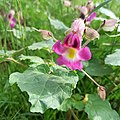
The Tohono Oʼodham are a Native American people of the Sonoran Desert, residing primarily in the U.S. state of Arizona and the northern Mexican state of Sonora. The United States federally recognized tribe is the Tohono Oʼodham Nation.

Senegalia greggii, formerly known as Acacia greggii, is a species of tree in the genus Senegalia native to the southwestern United States and northern Mexico, from the extreme south of Utah south through southern Nevada, southeast California, Arizona, New Mexico and western Texas to Baja California, Sinaloa and Nuevo León in Mexico. The population in Utah at 37°10' N is the northernmost naturally occurring Senegalia species anywhere in the world.

Phaseolus acutifolius, also known as the tepary bean, is a legume native to the southwestern United States and Mexico and has been grown there by the native peoples since pre-Columbian times. It is more drought-resistant than the common bean and is grown in desert and semi-desert conditions from Arizona through Mexico to Costa Rica. The water requirements are low. The crop will grow in areas where annual rainfall is less than 400 mm (16 in).

Rhinanthus minor, known as yellow rattle, is a herbaceous wildflower in the genus Rhinanthus in the family Orobanchaceae. It has circumpolar distribution in Europe, Russia, western Asia, and northern North America. An annual plant, yellow rattle grows up to 10–50 centimetres (3.9–19.7 in) tall, with upright stems and opposite, simple leaves. The fruit is a dry capsule, with loose, rattling seeds.

Harpagophytum, also called grapple plant, wood spider, and most commonly devil's claw, is a genus of plants in the sesame family, native to southern Africa. Plants of the genus owe their common name "devil's claw" to the peculiar appearance of their hooked fruit. Several species of North American plants in the genus Proboscidea and certain species of Pisonia, however, are also known by this name. Devil's claw's tuberous roots are used in folk medicine to reduce pain.
Devil's claw may refer to:

Mucuna pruriens is a tropical legume native to Africa and tropical Asia and widely naturalized and cultivated. Its English common names include monkey tamarind, velvet bean, Bengal velvet bean, Florida velvet bean, Mauritius velvet bean, Yokohama velvet bean, cowage, cowitch, lacuna bean, and Lyon bean. The Tshivenda/Venda language name is Vhulada.

Martyniaceae is a family of flowering plants in the Lamiales order that are restricted to the Americas. The family was included in Pedaliaceae in the Cronquist system but is recognized as a separate family by the Angiosperm Phylogeny Group on the basis of phylogenetic studies that show that the two families are not closely related. Both families are characterized by having mucilaginous hairs — which give the stems and leaves a slimy or clammy feel — and fruits with hooks or horns. Some members of the genus Proboscidea are known as "unicorn plant" or "devil's claw" because of their horned seed capsules.
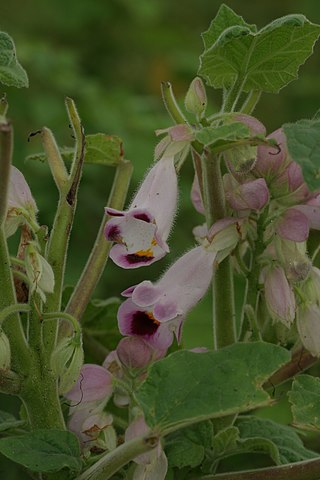
Martynia is a monotypic genus in the Martyniaceae family consisting of a single species, Martynia annua L., which is commonly known as cat's claw, tiger's claw, iceplant. or Devil's claw. However, the name 'iceplant' may also refer to members of the unrelated plant family Aizoaceae.

Neltuma glandulosa, formerly Prosopis glandulosa, commonly known as honey mesquite, is a species of small to medium-sized, thorny shrub or tree in the legume family (Fabaceae).

Juncus acutus, the spiny rush, sharp rush or sharp-pointed rush, is a flowering plant in the monocot family Juncaceae. It is native to the Americas, Northern and Southern Africa, Western and Southern Europe and West Asia, and is found in a variety of wet habitats, such as bogs, fens, meadows, and salt marshes, and along the edges of ponds and lakes.
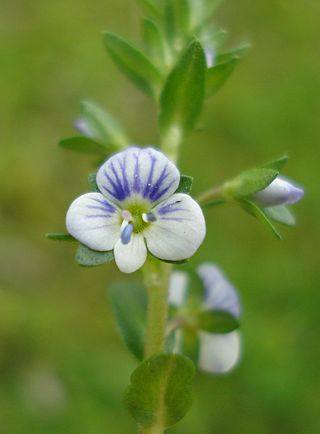
Veronica serpyllifolia, the thyme-leaved speedwell or thymeleaf speedwell, is a perennial flowering plant in the plantain family. The species as a whole is native mostly to Eurasia & North America, and has three variants with their individual ranges; var. serpyllifolia has particularly spread beyond its native range.
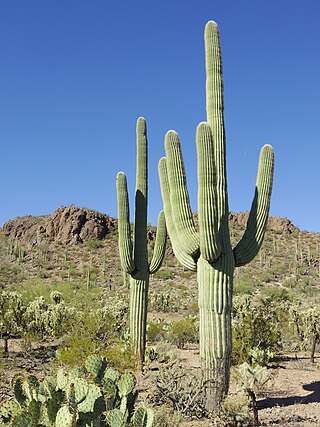
The saguaro is a tree-like cactus species in the monotypic genus Carnegiea that can grow to be over 12 meters tall. It is native to the Sonoran Desert in Arizona, the Mexican state of Sonora, and the Whipple Mountains and Imperial County areas of California. The saguaro blossom is the state wildflower of Arizona. Its scientific name is given in honor of Andrew Carnegie. In 1933, Saguaro National Park, near Tucson, Arizona, was designated to help protect this species and its habitat.

Terrol Dew Johnson (1973–2024) was a Tohono O'odham basket maker, sculptor, and health advocate, who promoted Indigenous food sovereignty to promote health and prevent diabetes.
Annie Antone is a Native American Tohono O'odham basket weaver from Gila Bend, Arizona.
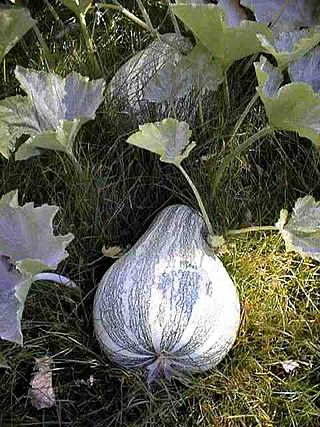
Cucurbita argyrosperma, also called the cushaw squash and silver-seed gourd, is a species of winter squash originally from the south of Mexico. This annual herbaceous plant is cultivated in the Americas for its nutritional value: its flowers, shoots, and fruits are all harvested, but it is cultivated most of all for its seeds, which are used for sauces. It was formerly known as Cucurbita mixta.

Proboscidea althaeifolia is a species of flowering plant in the family Martyniaceae known by the common names desert unicorn-plant and yellow-flowered devil's claw. It is native to the desert southwest of the United States, where it grows in sandy habitat and blooms during the hot summer. This is a perennial herb growing from a thick, tuberlike yellow root. The stem is decumbent, creeping along the ground. The shiny leaves have rounded, oval, or roughly triangular blades up to 7 centimeters long which are deeply lobed and wavy along the edges. The inflorescence is an array of many showy, fragrant, bell-shaped flowers with five lobes flaring several centimeters wide. The flower is yellow to orange or apricot with an intricate pattern of speckles and streaks, its lower lobe lined with a nectar guide. The fruit is a large seed pod many centimeters long, a cylindrical body tapering into a very long, thin, curving tail. As the fruit dries the tail cracks open and splits into two hooked, claw-like halves. These hard, dry fruits were used as tools by local Native Americans.

Proboscidea parviflora is a species of flowering plant in the family Martyniaceae known by the common names doubleclaw and red devil's-claw. It is native to the desert southwest of the United States and northern Mexico, where it grows in sandy, dry, and disturbed habitat and blooms during the hot summer. This is an annual herb growing from a taproot and producing sprawling, spreading stems. The leaves have rounded, oval, or roughly triangular blades up to 15 centimetres (6 in) long which have smooth edges or faint lobes or teeth. The inflorescence is an array of several showy bell-shaped flowers with five lobes flaring several centimeters wide. The flower is white to pink or purple, sometimes with mottling or lines of spots in the throat, and often a purple blotch on the upper lip. A yellow nectar guide extends along the lower lip. The fruit is a large seed pod many centimeters long, a cylindrical body tapering into a very long, thin, curving tail. As the fruit dries the tail cracks open and splits into two hooked, claw-like halves. The young fruits and seeds were used for food and the dark-colored hardened dry fruits were used in basketry by local Native Americans.
Proboscidea sabulosa is a species of flowering plant in the family Martyniaceae known by the common names sanddune unicorn-plant, dune unicorn plant and dune devil's claw. It is native to Chihuahua in Mexico and New Mexico and Texas in the United States.
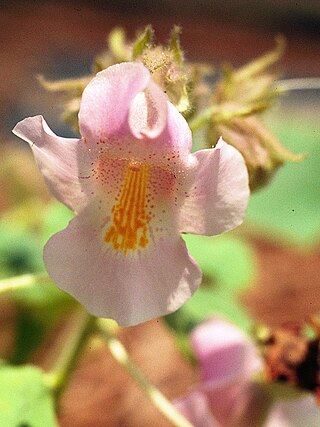
Proboscidea louisianica is a species of flowering plant in the family Martyniaceae. Its true native range is unclear, but probably includes parts of the southwestern United States and Mexico in North America. It occurs in other areas, including other regions in North America, Europe, Australia, and South Africa, as an introduced species. It is the most widely distributed species in its family. Common names it shares with other Proboscidea species include devil's claw and unicorn-plant. Names more specific to the species include common devil's claw, ram's horn, aphid trap, Louisiana unicorn-plant, purple-flowered devil's-claw, goat's head, elephant tusks, and martinoe.



